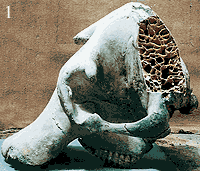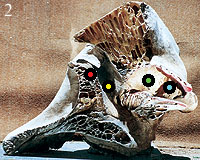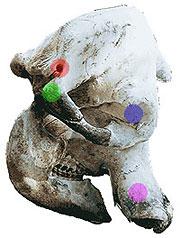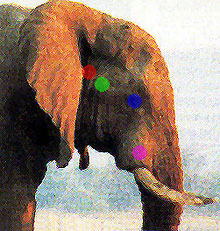Shot Placement
Elephants are always shot at close range. If an elephant is on to you, you’re not going to get a shot, and if he’s not, then there is no great difficulty getting to within 20 yards. It is doubtful that more than one in a hundred elephants are shot at much over 40 yards, and it is inconceivable to take more than a 60 yard shot on an unwounded elephant. Consequently, it should be possible to precisely place one’s bullet exactly where it should go. However, as elephant are usually hunted with heavy calibre rifles, flinching is a common problem, as is the fact that it is seldom possible to take a good rest unless one’s tracker is carrying some shooting sticks. The trick is to practice shooting offhand until you can consistently hit a 5" disk at 50 yards. If you cannot manage the recoil from the standing position to practice regularly... go to a rifle that kicks less (heavier stock, or lighter calibre or loads). Just because an elephant is huge it doesn’t necessarily mean that one has a large target, particularly if you wish to try a brain shot.
There have always been two schools of thought on the matter of whether to go for a heart or a brain shot. In the days of blackpowder rifles hunters were restricted to ‘behind the shoulder’ shots, since no lead bullet, however hardened has sufficient penetration for a brain or shoulder shot. When smokeless powder arrived along with jacketed bullets, the brain shot came into vogue, especially with the devotees of the small bore rifles. The facts are simple and the choices fairly logical. A bullet through the brain from a 7x57 will kill an elephant as instantly as a bullet from a .700 nitro. A bullet from a large bore that misses the brain may knock the animal out or at least stun him, (although this must not be taken as guaranteed). A bullet from a small bore that misses the brain will simply cause your elephant to vanish, at high speed, into the next province or country. The wound will heal in a remarkably short time and the elephant will be none the worse for wear, while you will be shy of your trophy fee.

Photo 1: Partial section through skull showing honeycomb structure. |

Photo 2: Skull cross-section showing position of brain cavity.
Dots indicating (from left to right):
External position of the eye.
Nasal cavity.
Brain cavity.
Position of the earhole. |
Whatever may be said for the heart or lung shot, many hunters insist on trying a brain shot. It is, after all The Classical shot on elephant, neat, clinical, and favoured by all the great elephant hunters of this century. There are also many situations where the brain shot is the only sensible option. When shooting a cow out of a herd, when shooting an elephant that has seen you and is facing or charging, or when, (as not infrequently happens) the head is all you can clearly see to shoot at (for there is no greater mistake than firing at where you THINK the heart/lungs are). It is therefore sensible for any sportsman to familiarise himself with the shot placement for a brain shot and if, as is usually the case these days, the hunter is being backed by a professional or a friend, by all means try a brain shot, even if you don’t need to. A brain shot elephant collapses instantly and all the person backing you has to do is aim for a heart shot, and, if the elephant is still in view half a second after you’ve fired, shoot, for the first shot has missed.
The elephant’s skull is truly unique, having to support not only the tusks, but also the trunk. As the trunk has no bones in it, all movement is achieved by a complex system of (massive) muscles and tendons which are all anchored to the skull. To fulfil these requirements, the skull has to be large, but, if it were solid bone, it would weigh too much, so the majority of the skull is composed of a ‘honeycomb’ of bone covered by an incredibly hard outer layer (see photos 1 & 2) In life, the surfaces of this ‘honeycomb’ bone are covered with a gelatinous substance. Unless fired from a quartering away shot into the back of the brain, any bullet has to pass through some 18" to 2½' of muscle and bone before it reaches the brain. The hard outer surface of the skull acts like armour plate, often causing the bullet to deflect if it hits it at too acute an angle, whilst the internal honeycomb and jelly absorb most of the ‘shock’ or concussion effect of the bullet. The brain is very small in relation to the head as a whole (its about twice the size of a human brain) and bullet placement is critical.
 |
 |
| Fig 2:- Visual comparison showing location of facial features relative to skull and shot placement. |
Dots indicating: (from top to bottom, left to right):
Earhole.
Zygomatic arch.
Eye socket.
Tusk socket.
|
By far the easiest is the side brain shot. From the side, the brain is about 12" long and 6" (at its midpoint) high in a bull (see fig 1 and photo 3) and 9" x 5" in a cow and situated low in the skull near the back. The forward part of the brain is, however, protected by the zygomatic processes (cheek bones see fig 2) which protrude from the skull, and tend to cause deflection of even the most solidly constructed bullet. The best advice is, therefore, to draw an imaginary line between the ear hole and the eye, and then shoot on this line 4" (a handsbreadth) in front of the ear hole (fig 2). If one is slightly behind the elephant, a shot straight into the ear hole works well. One word of caution. With the side brain shot the bullet will frequently exit, particularly the higher velocity numbers such as the .375 H&H , .404 etc. Most of the time bullets will continue straight along the path on which they entered the head. However, some will turn and exit the head at a downwards angle. It is not uncommon to see a kick of dust as the bullet hits the ground 30 to 40 metres away on the other side of the elephant. At least a couple of men have been killed on culling operations by bullets that have been turned by the skull, and it is particularly important to consider when shooting an animal out of a herd. Watch what is on the other side of your target!
|